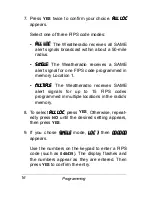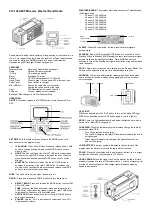
8
How Your Radio Works
New Alert Types
Your Weatheradio is designed to recognize all com-
mon weather alert types currently used by the NWS.
However, the NWS occasionally creates and broad-
casts new alert types (for which the Weatheradio’s
memory does not contain a specific, corresponding
description). If your Weatheradio receives a signal for
a new alert type, it is preset (if the alert function is
turned on) to display
81.12:1
81.12:1
81.12:1
81.12:1
, the alert description,
(
(0(5*(1&
(0(5*(1&
(0(5*(1&
(0(5*(1&
,
67$7(017
67$7(017
67$7(017
67$7(017
,
:$51,1*
:$51,1*
:$51,1*
:$51,1*
, or
:$7&+
:$7&+
:$7&+
:$7&+
), and
781(
781(
781(
781(
79
79
79
79
,
then sound a beeping alert.
UNDERSTANDING FIPS CODES
For the purpose of broadcasting weather information,
the NWS has divided the United States into regions
by state and county (or parish, where applicable) then
assigned a 6-digit FIPS code to identify each county
or parish. For example, the code for Tarrant County,
Texas, is 048439.
The first digit in a FIPS code identifies the county sub-
division, the next two digits identify the state, and the
last three digits identify the county or parish.
Note: Most FIPS codes begin with 0, which means
the code represents an entire county. The NWS, how-









































